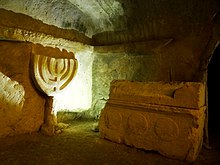
The Rabbinic period, or the Talmudic period,[1] denotes a transformative era in Jewish history, spanning from the destruction of the Second Temple in 70 CE to the Muslim conquest in 638 CE. Pivotal in shaping Judaism into its classical form, it is regarded as the second most important era in Jewish history after the Biblical period.[2]
After the failure of the Great Jewish Revolt of 66–73 CE, Roman measures such as the fiscus Judaicus (Latin for 'Jewish tax') and land confiscation severely impacted the Jewish population of Judaea. The destruction of Jerusalem and the Temple required Jewish culture to adapt in order to survive. Judaism endured through the establishment of new centers of scholarship and leadership, initially at Yavne under Yohanan ben Zakkai, who promoted a focus on Torah study and synagogue worship.[3][4] The next decades also saw the Jewish response to several catastrophic events, including the failed Diaspora uprisings of 115–117 CE and the Bar Kokhba revolt of 132–135 CE, a failed bid for the reestablishment of an independent Jewish state in Judaea.[4][5] The suppression of these revolts by the Romans led to the devastation of Judea proper as well as diaspora communities, the death and enslavement of many Jews, further displacement, and economic hardship.[4] Despite these challenges, Jewish communal life continued to thrive, particularly in the Galilee, which became a major center of Jewish life and scholarship.[6] The authority of the Patriarchs was instrumental in maintaining Jewish continuity during this transformative period.[6]

During the later Rabbinic period, the Jewish population in the Land of Israel continued to decline under Christianized Roman rule. Jews started facing discriminatory laws and religious persecution,[7] and many emigrated to flourishing Diaspora communities.[8] From the 3rd century onward, the Jewish community in Babylonia became a central hub of Jewish life, benefiting from a relatively tolerant environment under the Sasanian Empire.[5] Contemporary estimates frequently place the Babylonian Jewish population during this period at approximately one million, establishing it as the largest Jewish diaspora community of the time.[9] This period of economic prosperity and political freedom allowed the Babylonian Jewish community, led by the Exilarch, to thrive and foster significant theological and literary developments.[5] During the Rabbinic period, Jewish communities were also present in various regions of the Mediterranean, including Egypt,[10] North Africa,[10] Asia Minor,[10] Italy,[11] and Spain.[11]
The Rabbinic period was consequential in the ongoing development of Judaism and its traditions.[5] During this time, the Jewish religious practice transitioned from a focus on the Temple and sacrificial practices to a greater emphasis on Halakha (Jewish law) and Aggadah (biblical interpretation).[3] This period saw the creation of major texts of rabbinic literature, such as the Mishnah, Tosefta, Jerusalem Talmud, Babylonian Talmud, and various midrashim (biblical commentaries).[5] Jews maintained their cultural and religious identity by continuing to speak and write in Hebrew and Aramaic, and developed liturgy, including piyyutim (liturgical poetry). They set up synagogues and yeshivas, engaged in mysticism, and hoped for the Messiah to bring their exile to an end.[5]
| History of Israel |
|---|
 |
|
|
- ^ Schwartz, Seth (2004). "Historiography on the Jews in the 'Talmudic Period' (70–640 ce)". In Goodman, Martin (ed.). The Oxford Handbook of Jewish Studies. Oxford University Press. pp. 79–114. doi:10.1093/oxfordhb/9780199280322.013.0005. ISBN 9780191577260.
- ^ Katz, Steven. “Introduction.” Introduction. In The Cambridge History of Judaism, edited by Steven T. Katz, 1–22. The Cambridge History of Judaism. Cambridge: Cambridge University Press, 2006.
- ^ a b Eli Barnavi (editor), A historical atlas of the Jewish people : from the times of the Patriarchs to Present, London : Hutchinson, c1992, pages 66-69.
- ^ a b c Z. Baras, S. Safrai, M. Stern, Y. Tsafrir (editors), Eretz Israel from the destruction of the Second Temple to the Muslim Conquest, volume one, Jerusalem : Yad Ben Zvi, 1982, ISBN 9652170062 (Hebrew).
- ^ a b c d e f Katz, Steven (2006), Katz, Steven T. (ed.), "Introduction", The Cambridge History of Judaism: Volume 4: The Late Roman-Rabbinic Period, The Cambridge History of Judaism, vol. 4, Cambridge: Cambridge University Press, pp. 1–2, doi:10.1017/chol9780521772488.002, ISBN 978-0-521-77248-8, retrieved 7 August 2024
- ^ a b Cite error: The named reference
historyawas invoked but never defined (see the help page). - ^ הר, משה דוד (2022). "היהודים בארץ-ישראל בימי האימפריה הרומית הנוצרית" [The Jews in the Land of Israel in the Days of the Christian Roman Empire]. ארץ-ישראל בשלהי העת העתיקה: מבואות ומחקרים [Eretz Israel in Late Antiquity: Introductions and Studies] (in Hebrew). Vol. 1. ירושלים: יד יצחק בן-צבי. pp. 210–212. ISBN 978-965-217-444-4.
- ^ Ehrlich, Michael (2022). The Islamization of the Holy Land, 634–1800. Arc Humanities Press. pp. 3–4. ISBN 978-1-64189-222-3. OCLC 1302180905.
The Jewish community strove to recover from the catastrophic results of the Bar Kokhva revolt (132–135 CE). Although some of these attempts were relatively successful, the Jews never fully recovered. During the Late Roman and Byzantine periods, many Jews emigrated to thriving centres in the diaspora, especially Iraq.
- ^ Gafni, Isaiah (2006), Katz, Steven T. (ed.), "The Political, Social, and Economic History of Babylonian Jewry, 224–638 CE", The Cambridge History of Judaism: Volume 4: The Late Roman-Rabbinic Period, The Cambridge History of Judaism, vol. 4, Cambridge: Cambridge University Press, p. 805, doi:10.1017/chol9780521772488.033, ISBN 978-0-521-77248-8, retrieved 10 September 2024
- ^ a b c Kerkeslager, Allen; Setzer, Claudia; Trebilco, Paul; Goodblatt, David (2006), Katz, Steven T. (ed.), "The Diaspora from 66 to c. 235 ce", The Cambridge History of Judaism: Volume 4: The Late Roman-Rabbinic Period, The Cambridge History of Judaism, vol. 4, Cambridge: Cambridge University Press, pp. 67–68, 82, doi:10.1017/chol9780521772488.004, ISBN 978-0-521-77248-8, retrieved 7 August 2024
- ^ a b Rutgers, Leonard; Bradbury, Scott (2006), Katz, Steven T. (ed.), "The Diaspora, C. 235–638", The Cambridge History of Judaism: Volume 4: The Late Roman-Rabbinic Period, The Cambridge History of Judaism, vol. 4, Cambridge: Cambridge University Press, pp. 492, 508–509, doi:10.1017/chol9780521772488.021, ISBN 978-0-521-77248-8, retrieved 7 August 2024